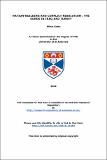Files in this item
Nation-building and conflict resolution : the Kurds in Iraq and Turkey
Item metadata
| dc.contributor.advisor | Hinnebusch, Raymond A. | |
| dc.contributor.author | Saito, Miwa | |
| dc.coverage.spatial | 307p. | en_US |
| dc.date.accessioned | 2017-06-26T12:18:29Z | |
| dc.date.available | 2017-06-26T12:18:29Z | |
| dc.date.issued | 2002 | |
| dc.identifier | uk.bl.ethos.526051 | |
| dc.identifier.uri | https://hdl.handle.net/10023/11083 | |
| dc.description.abstract | This thesis is a study of national integration policies as a method of conflict resolution. It assumes that a nation can be multiethnic and integrative, rather than ethnically homogeneous and exclusive. Instead of seeking outright separatism for ethnonational conflicts, it explores ways to integrate sizeable ethnic groups through suitable nation-building policies, in this case, the Kurds. To justify the above hypothesis, this study analyses two theoretical frameworks, first, the prototypical national integration theory based on Karl W. Deutsch's work, and second, Revolution from Above based on Ellen K. Trimberger's work. This study regards Revolution from Above as an effective method for newly established states to consolidate administrative capabilities, which are vital to political institutionalisation. Particularly, nation-building through Revolution from Above is deemed suitable for redressing the problems posed by arbitrarily drawn national borders, as reforms conducted by such governments are designed to compensate for the lack of pre-existing national unity, such as provision of national education, welfare, and economic development. This study then examines two specific cases of nation-building, in Turkey and in Iraq, and in particular how they faced the challenge of integrating their substantial Kurdish minorities. Turkey is treated as a representative case of nation-building through Revolution from Above, and Iraq is treated as an example in which equivalent nation-building measures to the Turkish case were absent, owing to the mandate rule by Britain in its earliest period. This empirical chapter will be presented in four key phases which are: (1) The Legacy of Ottoman Centralisation, (2) State Formation, (3) Political Mobilisation, and (4) Integration or Containment? Finally, this study will examine the impact of foreign intervention on the relations between governments and minorities. The failed national integration that is manifest in totalitarian state-structure will be discussed, as it may trigger political and military interventions by foreign powers. The final chapter examines the two test cases, based on Kurdish nationalists' contacts with foreign states and organisations in the 1920s and in the 1990s. | en_US |
| dc.language.iso | en | en_US |
| dc.publisher | University of St Andrews | |
| dc.subject.lcc | DS51.K7S2 | |
| dc.subject.lcsh | Kurds | en |
| dc.title | Nation-building and conflict resolution : the Kurds in Iraq and Turkey | en_US |
| dc.type | Thesis | en_US |
| dc.type.qualificationlevel | Doctoral | en_US |
| dc.type.qualificationname | PhD Doctor of Philosophy | en_US |
| dc.publisher.institution | The University of St Andrews | en_US |
This item appears in the following Collection(s)
Items in the St Andrews Research Repository are protected by copyright, with all rights reserved, unless otherwise indicated.

